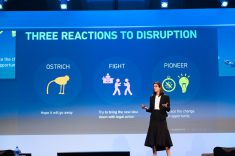
Disruption is a buzzword in business circles. However, this term is mostly misunderstood. Few businesses know whether they should disrupt or simply innovate to better compete. We recognize that both are inevitable and necessary in active business, but is there really a difference between innovating and disrupting?

Is there a distinction between disruption and innovation?
Shilen Patel is the Co-founder and Director of Independents United, a highly entrepreneurial creative agency. He recently said that innovation is ‘based on accurate data’. Patel therefore considers innovation to be rational.
On the other hand, Patel differentiated disruption from innovation by insisting that disruption is irrational.
Indeed, innovation follows rational rules to achieve new technical ideas. As an example, Shilen Patel evokes the well-known OTA (Online Travel Agency): Hotels.com as rational but describes the classic disrupter Airbnb as irrational.
Hotels.com is rational because it is based on the same algorithms and layout as other OTAs. It is based on the same hotel pricing and marketing strategy (ie: discount messages or best prices guarantee banners).
Airbnb is irrational because it did not require any major innovation. For example, the company did not need to develop any infrastructure with complicated processes to launch its service. The online experience is slightly different than from that of an OTA. Airbnb is made to bring people together with a more user-friendly online layout.
Innovation is a new idea that benefits a targeted market and specified group of people. Consequently, the size of this innovation has a large beneficial impact on the market. In the case of an important innovation, the whole industry won’t change, it will simply adapt itself around this improvement.
Disruption, on the other hand, is the consequence of an innovation that has a huge impact on a whole industry.
 The concept of Disruptive Innovation
The concept of Disruptive InnovationIn a fast paced world, disruption cannot exist without innovation and technology.
This term “disruption” was initiated and analyzed for the first time in the 1990’s by a Harvard Business School professor, Clayton M. Christensen, who had a profound influence on many business leaders.
Written in 1997, in his book called “Innovation’s Dilemma”, Christensen explains that disruptive innovation is actually a very specific type of innovation that creates a new market and value network in an unpredictable environment.
It replaces traditional methodology. For example, a product that tends to be disrupted is generally a product or service which was too sophisticated, too expensive and too complicated for customers.
Concretely, disruption is most often built on new technology. Disruption transforms the product to make it more accessible and more affordable to a larger part of the population.
As a result, the market is segmented, redefined and mainstreamed. The targeted customer is clearer about the corresponding service. The product fits better with the segmented part of the market, and attracts new customers. The product becomes simpler.
For more information about disruptive innovations, here are some videos:
Disruptive Innovation definition by HBS,
Explanation by Clayton M. Christensen.
Getting back to Shilen Patel’s definitions of innovation versus disruption, he believes that the question all entrepreneurs or corporate decision-makers must ask themselves, and the decision they must make are:
Is my industry facing large-scale unpredictable change?
|
“ Share your skills and your know-how with anyone who has an interest in the fine art of breakthrough innovation . ”
Elmar Mock, Co-inventor Swatch & Founder Creaholic. “ Be first, different and unique through disruptive innovation. ”
Jean-Claude Biver, CEO TAG Heuer & Hublot SA. |
Everyone recognizes that the Cab-company Uber is the pioneer of the sharing economy.
Since 2009, Uber offers a portfolio of services that tends now to deviate from its original driving experience. Uber has a dynamic pricing business model with cashless payment method based on a strong collaborative business. Uber adapts itself to the new needs of supply and demand by developing new supply, such as helicopter service or Uber Health, which delivers emergency cab services in certain countries.
Christensen explained earlier that disruption originally starts from the low end of the market. Following his thinking, Uber cannot be considered as a disruptor because it has not moved up from the low end. Rather, it started directly from the mainstream market.
Instead, Uber is an improvement, an alternative to what already exists within the traditional taxi industry. Uber developed within the same market, targeting people wishing spontaneously to use a car like taxi. Consequently, no new market has been created.
This is the reason why taxi drivers and companies are so unhappy about having Uber in their markets. Uber steals their clients. Christensen evokes the notion of sustaining innovation for Uber of simply improving a service. Which begs the question: what exactly is a sustaining innovation?
Disruption is an active business solution and strategy in response to competition. This is a specific type of innovation that we can divide into three distinct categories, two of which are closely related to disruption:
Innovation is an integral part of disruption. New technologies are quickly changing and the competition is fierce. They both represent fundamental approaches to areas where the necessity of innovation leads to success.
When traditional methods fail, disruption is, in some cases, the only remedy.
Disruption is about creating a ripple effect. It is up to entrepreneurs to be smarter and quicker than competitors. The only way for industry giants to fight back is by launching their own disruptive strategy with a separate business model.
Sources :
http://www.claytonchristensen.com/key-concepts/
https://www.weforum.org/agenda/2016/06/what-is-disruptive-innovation/
http://www.heg-fr.ch/FR/Formation/Formation-postgrade/Pages/cas-managing.aspx
https://www.inc.com/dave-bailey/why-airbnb-is-disruptive-innovation-and-uber-is-not.html
https://www2.deloitte.com/il/en/pages/strategy/articles/disruptive_vs_sustaining.html#
https://blog.stormid.com/2017/05/innovation-and-disruption/
Image credits: Cognizant Technology Solutions via Wikimedia Commons, and Kay Kim via Flickr
A really thought-provoking article. I would never have guessed there was so much differentiation in innovation, or that it would make this increasingly frequent occurence easier for its product end-users to understand.
Many thanks Nicholas for your comment!